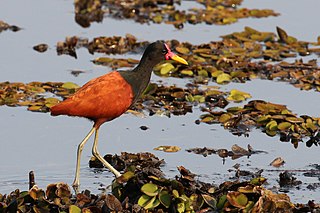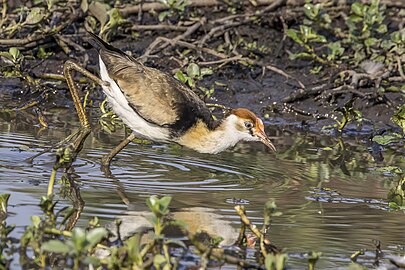
The American avocet is a large wader in the avocet and stilt family, Recurvirostridae, found in North America. It spends much of its time foraging in shallow water or on mud flats, often sweeping its bill from side to side in water as it seeks crustacean and insect prey.

The Pacific golden plover is a migratory shorebird that breeds during summer in Alaska and Siberia. During nonbreeding season, this medium-sized plover migrates widely across the Pacific.

The willet is a large shorebird in the family Scolopacidae. It is a relatively large and robust sandpiper and is the largest of the species called "shanks" in the genus Tringa. Its closest relative is the lesser yellowlegs, a much smaller bird with a very different appearance apart from the fine, clear, and dense pattern of the neck, which both species show in breeding plumage. It breeds in North America and the West Indies and winters in southern North America, Central America, the West Indies and South America.

The Caspian tern is a species of tern, with a subcosmopolitan but scattered distribution. Despite its extensive range, it is monotypic of its genus, and has no accepted subspecies. The genus name is from Ancient Greek hudros, "water", and Latin progne, "swallow". The specific caspia is from Latin and, like the English name, refers to the Caspian Sea.

The long-toed stint is a small wader. The genus name is from Ancient Greek kalidris or skalidris, a term used by Aristotle for some grey-coloured waterside birds. The specific subminuta is from Latin sub, "near to" and minuta, "small" from its similarity to the little stint, Calidris minuta.

The purple gallinule is a swamphen in the genus Porphyrio. It is in the order Gruiformes, meaning "crane-like", an order which also contains cranes, rails, and crakes. The purple gallinule is a rail species, placing it into the family Rallidae. It is also known locally as the yellow-legged gallinule. The specific name martinica denotes "of Martinique".

The African jacana is a wader in the family Jacanidae. It has long toes and long claws that enables it to walk on floating vegetation in shallow lakes, its preferred habitat. It is widely distributed in sub-Saharan Africa. For the origin and pronunciation of the name, see Jacanidae.

The bronze-winged jacana is a wader in the family Jacanidae. It is found across South and Southeast Asia and is the sole species in the genus Metopidius. Like other jacanas it forages on lilies and other floating aquatic vegetation, the long feet spreading out its weight and preventing sinking. The sexes are alike but females are slightly larger and are polyandrous, maintaining a harem of males during the breeding season in the monsoon rains. Males maintain territories, with one male in the harem chosen to incubate the eggs and take care of the young. When threatened, young chicks may be carried to safety by the male under his wings.

The pheasant-tailed jacana is a jacana in the monotypic genus Hydrophasianus. Like all other jacanas, they have elongated toes and nails that enable them to walk on floating vegetation in shallow lakes, their preferred habitat. They may also swim or wade in water reaching their body while foraging mainly for invertebrate prey. They are found in tropical Asia from Yemen in the west to the Philippines in the east and move seasonally in parts of their range. They are the only jacanas that migrate long distances and have different non-breeding and breeding plumages. The pheasant-tailed jacana forages by swimming or by walking on aquatic vegetation. Females are larger than males and are polyandrous, laying several clutches that are raised by different males in their harem.

The fulvous whistling duck or fulvous tree duck is a species of whistling duck that breeds across the world's tropical regions in much of Mexico and South America, the West Indies, the southern United States, sub-Saharan Africa and the Indian subcontinent. It has plumage that is mainly reddish brown, long legs and a long grey bill, and shows a distinctive white band across its black tail in flight. Like other members of its ancient lineage, it has a whistling call which is given in flight or on the ground. Its preferred habitat consists of wetlands with plentiful vegetation, including shallow lakes and paddy fields. The nest, built from plant material and unlined, is placed among dense vegetation or in a tree hole. The typical clutch is around ten whitish eggs. The breeding adults, which pair for life, take turns to incubate, and the eggs hatch in 24–29 days. The downy grey ducklings leave the nest within a day or so of hatching, but the parents continue to protect them until they fledge around nine weeks later.

The wattled jacana is a wader in the family Jacanidae found throughout much of South America east of the Andes, as well as western Panama and Trinidad. It is the only species in the Jacanidae family with such a large distribution. Wattled jacanas have long toes and claws which help them walk through aquatic vegetation. Like the majority of species of jacanas, the female is larger than the male, and forms harems of up to 4 or 5 males at any given time. There is also a major difference in proportional development or ornamentation and defense relative to body size when compared to males.

The northern jacana or northern jaçana is a wader which is known as a resident breeder from coastal Mexico to western Panama, and on Cuba, Jamaica and Hispaniola in the Caribbean. It sometimes known to breed in Texas, United States, and has also been recorded on several occasions as a vagrant in Arizona. The jacanas are a group of wetland birds, which are identifiable by their huge feet and claws, which enable them to walk on floating vegetation in the shallow lakes that are their preferred habitat. In Jamaica, this bird is also known as the 'Jesus bird', as it appears to walk on water. Jacana is Linnæus' scientific Latin spelling of the Brazilian Portuguese jaçanã, pronounced, from the Tupi name of the bird. See jacana for pronunciations.

The least grebe, an aquatic bird, is the smallest member of the grebe family. It occurs in the New World from the southwestern United States and Mexico to Argentina, and also on Trinidad and Tobago, the Bahamas and the Greater Antilles.

The banded lapwing is a small to medium-sized shorebird, found in small parties or large flocks on bare ground in open grasslands, agricultural land and open savannah. It is native to Australia and in the past considered as a game bird for hunting. Population estimate is 25 000 - 1 000 000. Other names include banded, black-breasted, brown flock and plain plover.

The white-necked heron or Pacific heron is a species of heron that is found on most of the Australian continent wherever freshwater habitats exist. It is also found in parts of Indonesia and New Guinea, but is uncommon in Tasmania. The populations of this species in Australia are known to be nomadic like most water birds in Australia, moving from one water source to another, often entering habitats they have not previously occupied, taking advantage of flooding and heavy rain where the surplus of food allows them to breed and raise their young. Irruptive movements may occur when environmental conditions are right in places where the species has been rare or absent.

Latham's snipe is a medium-sized, long-billed, migratory snipe of the East Asian–Australasian Flyway.

The red-capped plover, also known as the red-capped dotterel, is a small species of plover.

The long-toed lapwing , also known as the long-toed plover, is a species of wading bird in the lapwing subfamily, within the family Charadriidae. It is mainly sedentary and found across central and eastern Africa, from Chad and South Sudan in the north to Mozambique in the southeast of its range. It is one of 13 species of ground-nesting lapwings found in Africa.

The lesser jacana is a wader in the family Jacanidae and can be found in Africa. It can be recognized by its long legs and claws that allow it to walk on aquatic vegetation – although it is not to be confused with the larger African Jacana. The lesser jacana is insectivorous. Its conservation status is of least concern.

The Australian pratincole is a species of bird in the family Glareolidae. It breeds in Australia's interior; it winters to northern and eastern parts of the continent, Indonesia and New Guinea. It is a medium-sized nomadic shorebird which is commonly found in arid inland Australia. It breeds predominantly from south-western Queensland to northern Victoria and through central Australia to the Kimberley region in Western Australia. The Australian population is estimated at 60,000 individuals. They are a migratory species that generally move to the southern parts of their distribution range to breed during spring and summer. During winter they migrate to northern Australia, New Guinea, Java, Sulawesi and southern Borneo to over-winter. Although they are common, their occurrence is unpredictable and varies in location.



























